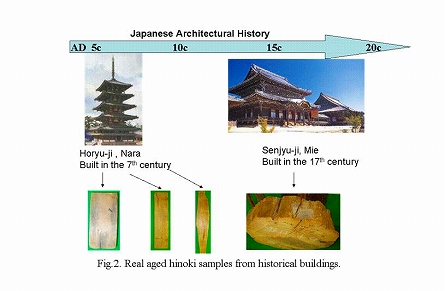|
|
|
Humanities and sciences of wood I
|
|
|
| Evaluation of Aging Wood from Japanese Historical Buildings |
|
|
Antique-like appearance Hinoki |

|
In Japan there are so many historical buildings. Especially, the ancient capitals Kyoto and Nara have many traditional wooden buildings, some of which are listed as a World cultural heritage of the UNESCO or as a National Property of Japan.
Wood used for the building materials might change its properties during usages. Therefore, the aging of wood can be of critical importance to traditional carpenters, Buddhist sculptors, art craftsman, museum curators and conservators as well as scientists in the field of art history, architectures, conservation science and wood science. Carpenters have an empiric and old knowledge that leads them to know when a timber needs to be changed. They often estimate age of wood with their naked eye. Features often used are color, odor, density and hardness. Thus the experience and judgment of them is vital.
Wood materials perform differently under various conditions. The degradation of wood is, in general, classified into three categories, i.e., weathering bio-degradation and aging. Aging is defined as a slow oxidation process caused by oxygen in the air. Therefore, based on the temperature-time conversion law an accelerated aging test was performed by heat treatment.
The main purpose of this study is to evaluate the durability and degradation of wood; furthermore, it aims at obtaining an efficient and easy method to evaluate the strength of wood timbers in old structures like temples or shrines. This study aims at understanding and evaluating properties of an old timber.
First, Hinoki (Chamaecyparis obtusa) specimens were subjected to the heat treatment 180℃, 150℃, 120℃,and 90℃ respectively under various treatment time by normal oven method. An accelerated aging test was performed by heat treatment to obtain different levels of accelerated aging wood samples.
Secondly, naturally aged hinoki, some samples of Dr. J. Kohara old timber collections at the xylarium of RISH, were used. Oldest samples came from timbers of Horyuji Temple used in the 6th century. Horyuji Temple in Nara, at over 1300 years ago, is one of the oldest remaining wooden structures in the world. The age of these samples are measured by dendrochronology (Dr. Mitsutani, Nara National Cultural Properties Research Institute) and radioactive carbon chronology (Dr. Imamura, et al. National Museum of Japanese history), respectively.
A comparison will be lead between mechanical and chemical properties of naturally aged wood and that of heat-treated wood. These results can be used as the standards in comparison with the actual naturally aged wood materials. Future plan is to collect the old timbers from typical historical buildings to create a database of them, in the perspective of better understanding the history of wooden materials. |
 |
|
| |